16 min read • Technology & innovation management
11 technology trends for post-crisis success
Breakthrough innovations for future competitive advantage


Executive Summary
BUILDING A SUCCESSFUL DIGITAL & SUSTAINABLE FUTURE
Accelerated by the COVID-19 pandemic, digitalization has dramatically increased over the last two years, both within companies and across society. At the same time, pressure on companies to counter climate change through new products, processes, and purpose has also grown. Both of these drivers have moved a wide range of technology topics up the strategic agenda for executives, who have often been forced to take immediate action in response to changing trends, new regulations, or the activities of competitors.
Uncertainty and change are continuing in 2022. Geopolitical conflicts are stirring up long-forgotten fears with unimagined and far-reaching consequences for the entire global economy. Watching the news, we can often feel as if everything we previously viewed as fixed and constant has disappeared to be replaced by an alternate reality.
However, uncertainty provides opportunities. One of the biggest threats for organizations is that they miss potential upsides where technology can deliver lasting value or that they are held back by failing to adopt new innovations and ways of working.
To help executives, Arthur D. Little (ADL) has worked with clients to identify some of the most important current and future technology trends, focusing on those that provide the highest business impact in terms of effectiveness and efficiency moving forward. Companies that manage to successfully address these trends will position themselves to build sustainable competitive advantage in the form of higher customer and employee satisfaction, cost benefits, and, most importantly, an edge in technology knowledge and skills.
In this Report, we provide an overview of 11 key trends: from essential foundations (e.g., data-driven business models) to areas that enable competitive differentiation (e.g., artificial intelligence [AI]-empowered business process automation).
1
DATA-DRIVEN BUSINESS MODEL INNOVATION
SHIFT FROM TECHNOLOGY COMPETITION TO ECOSYSTEM SERVICES
Across all sectors, data has become the new currency, with more and more companies basing their business models on data collection and usage.
However, focusing solely on a company’s own business model can narrow thinking and limit the possibilities data can deliver. Often, the real value of data comes from its flexibility and its potential to provide a complete picture. Over half of the value add of data-driven business models stems from ecosystems.
Organizations looking for new business opportunities around data should therefore think cooperatively across industries to leverage the full potential of data-driven business models (see Figure 1). Rather than simply seeing data primarily as a resource to improve existing business models, organizations should instead focus on how their available data can add value to their ecosystem.
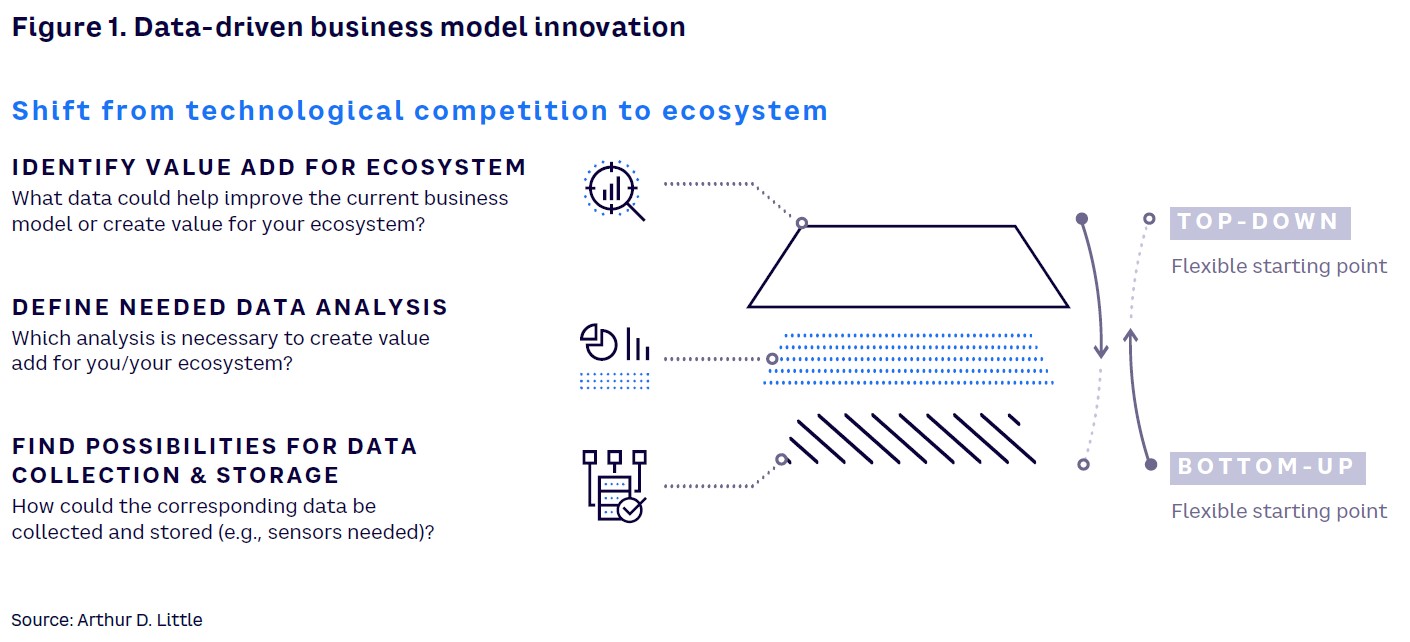
When defining the organization’s ecosystem, it is essential to think very broadly and not just focus on the organizations that it interacts with already. It is imperative to look at the bigger picture.
A good example of where data-driven business innovation and collaboration have delivered success is at global flavorings company McCormick, which we featured in our recent ADL Report, “From Insight to Impact.”[1] The company creates new flavorings for customers to incorporate into their products, with the aim of providing a range of options that spans low-innovation, staple products with a high potential for market success as well as more innovative novelty products.
Previously, creating new flavors was a manual process, with product developers combining elements and choosing potential options. Given the enormous range of combinations, it is impossible to manually evaluate each one. McCormick has now worked with IBM to develop an AI system that explores and combines all options within predefined conditions, delivering flavorings with high potential for market success as well as novelty options. Pairing McCormick’s global expertise with leading AI research helped the company accelerate the speed of flavor innovation and deliver highly effective, consumer-preferred formulas.
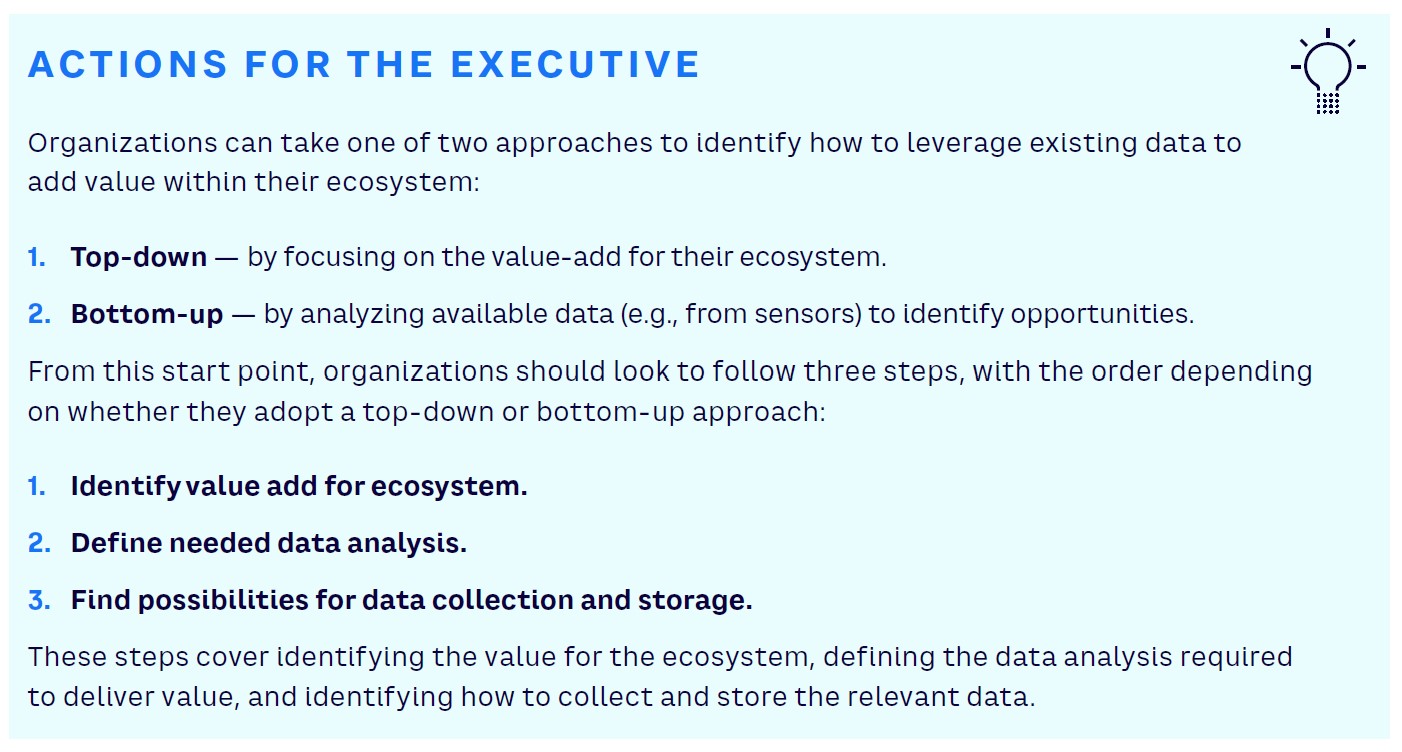
2
GREEN TECH INVESTMENT FOCUS
GREEN TRANSITION FOR COMPETITIVE EDGE
Our (economic) life is based on the consumption of resources — in the past, present, and future. We classify entire epochs based on the resources that define them, such as the Stone, Copper, Bronze, and Iron Ages. Yet these classifications demonstrate how transient the need for particular resources are.
Today we are facing nothing less than the emergence of a new epoch: the Green Age. Triggered by the desire to combat climate change and reinforced by the urge to reduce geopolitical dependencies through supply chains, a radical change in the socio-technical regime is emerging.
This transition is accompanied by previously unimagined opportunities for companies to gain competitive advantage. Using resources more efficiently and successfully transitioning to green energy are central to future success for industrial companies. The range of potential technologies is wide, with a major focus on sustainable energy production, storage, and more efficient power distribution. This focus is driving the allocation of capital, particularly from (institutional) investors.
These opportunities and ever greater consumer, political, and regulatory pressures are also shaping the CEO’s future strategic agenda. Many are already embracing the opportunity. For example, CEOs of companies such as Deutsche Telekom and IBM have formed the European Green Digital Coalition to aid the implementation of the EU’s Declaration on a Green and Digital Transformation strategy.
In our recent Prism piece “The Green Gambit,”[2] we explain in some detail why now is a perfect time for companies to make bold strategic moves in green investments (see Figure 2). Companies are in a position to adopt a new focus on nurturing disruptive ventures and redefining their role as part of a broader ecosystem, and collaborating with others to shift toward a greener economy. Who dares wins.
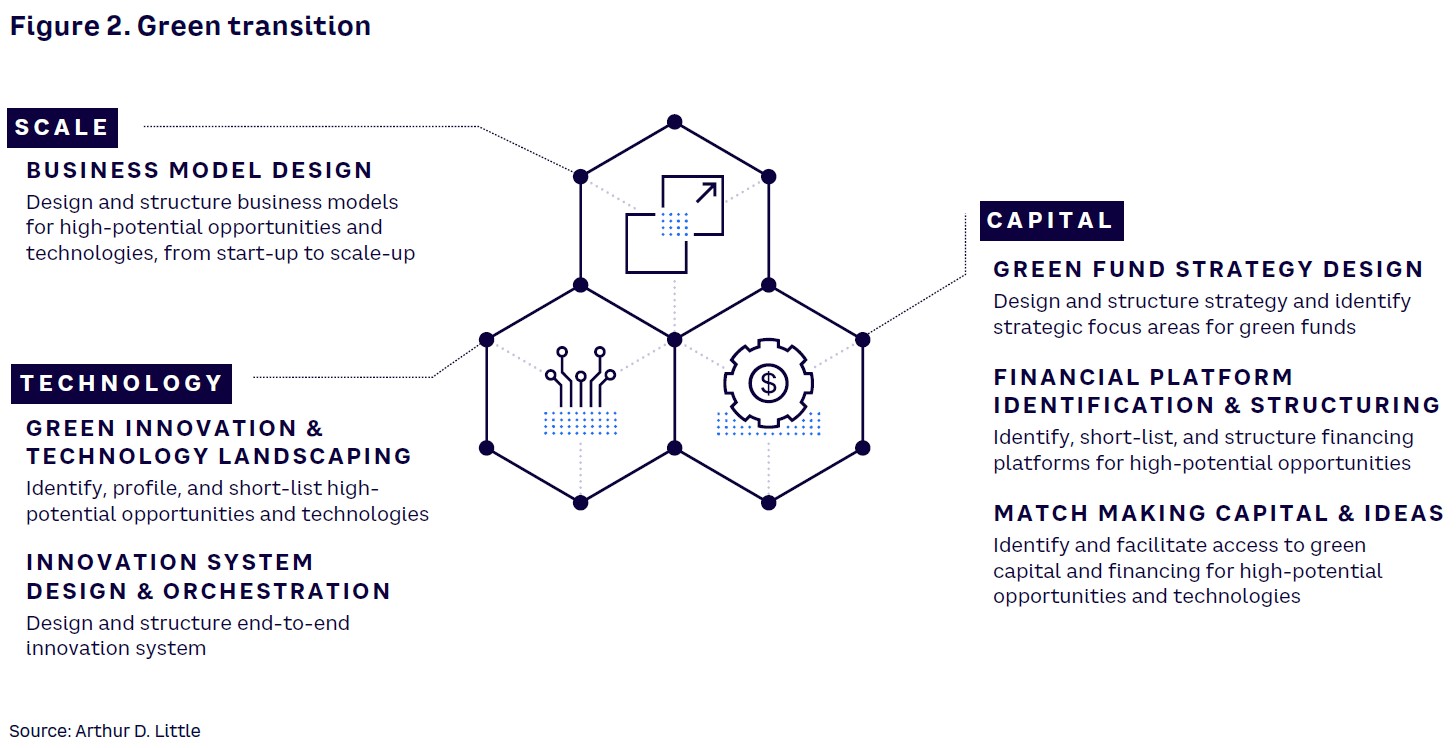
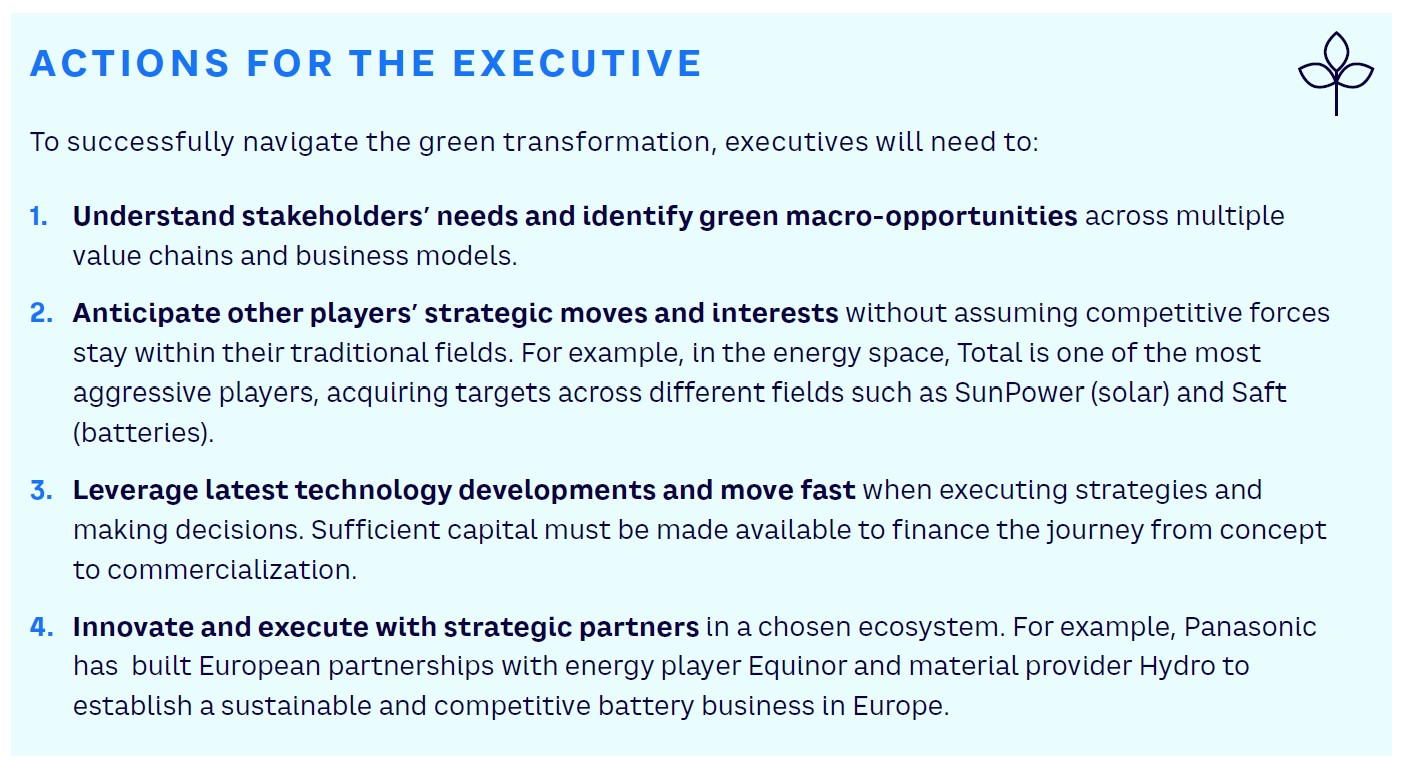
3
HUMAN-MACHINE FUSION
MOST OCCUPATIONS COULD SEE ACTIVITIES SHIFT TO HYBRID APPROACH
Previously it has been clear which tasks are allocated to humans and which to machines. Either the machine is faster, more reliable, or more precise, or if the tasks are too complex or creative, they need to be handled by humans.
We are on now on the verge of a new era where technology innovation will lead to a fundamental shift both in business and society, establishing entirely new working relationships between humans and machines.
Certain routine tasks will be allocated to machines and AI algorithms, enabling workers to focus on higher-value tasks. However, in their roles, humans will increasingly work in conjunction with technology (see Figure 3).
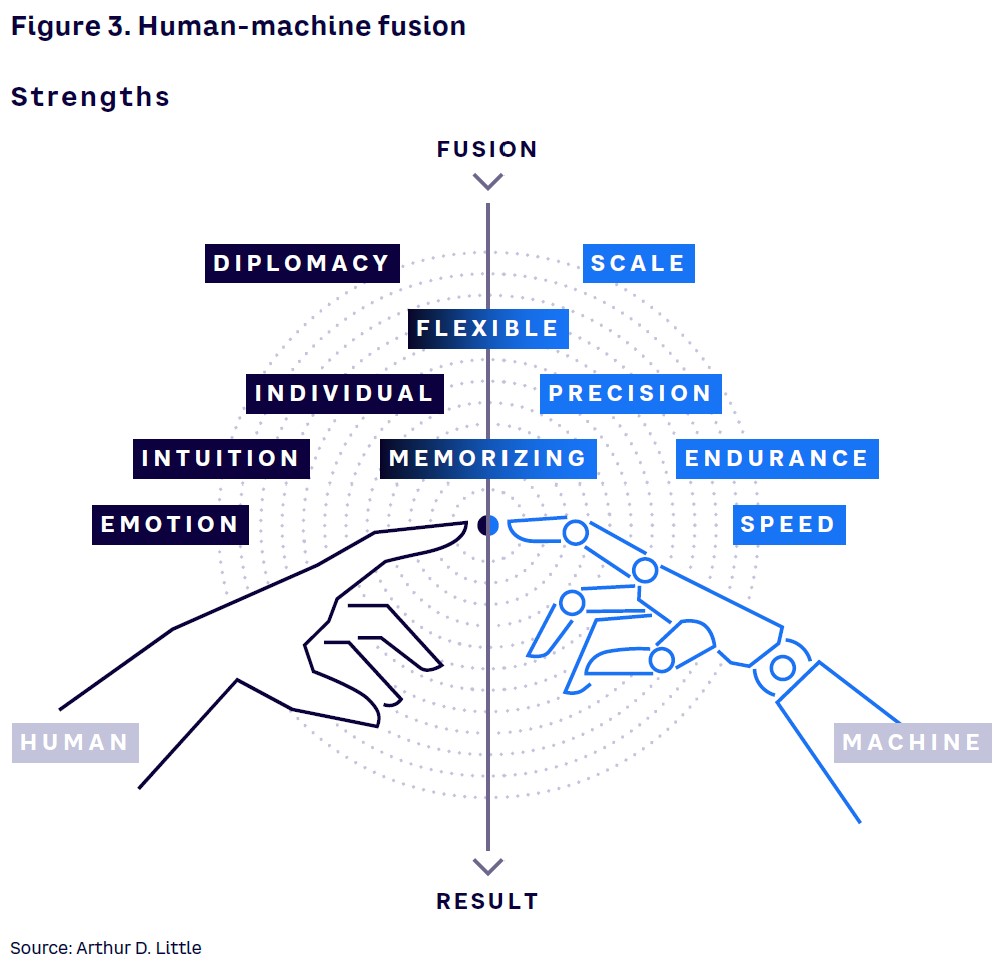
The space in which tasks and execution will occur is also changing. We have already experienced new forms of technology-enabled hybrid working during the pandemic. However, developments such as the metaverse will take this to an entirely new level. It will create new symbiotic spaces in which humans and machines will be empowered to seamlessly work in conjunction. In our recent article, “Metaverse: The Lego Bricks,”[3] we introduced a framework that explains the foundational building blocks of the metaverse and its stages of development.
This human-machine fusion will have major implications for both workers and society more generally, which need to be understood and communicated. It also provides tremendous potential to unlock the next wave of sustainable operational performance improvements for businesses and societies alike.
Human-machine fusion is already becoming a reality. Email programs automatically suggest replies based on the content of messages, chatbots take customers through the process of returning an item, and voice analysis routes calls to the most relevant department without an operator’s involvement. This bot-based empowerment is just one of the many growing examples of human-machine fusion.
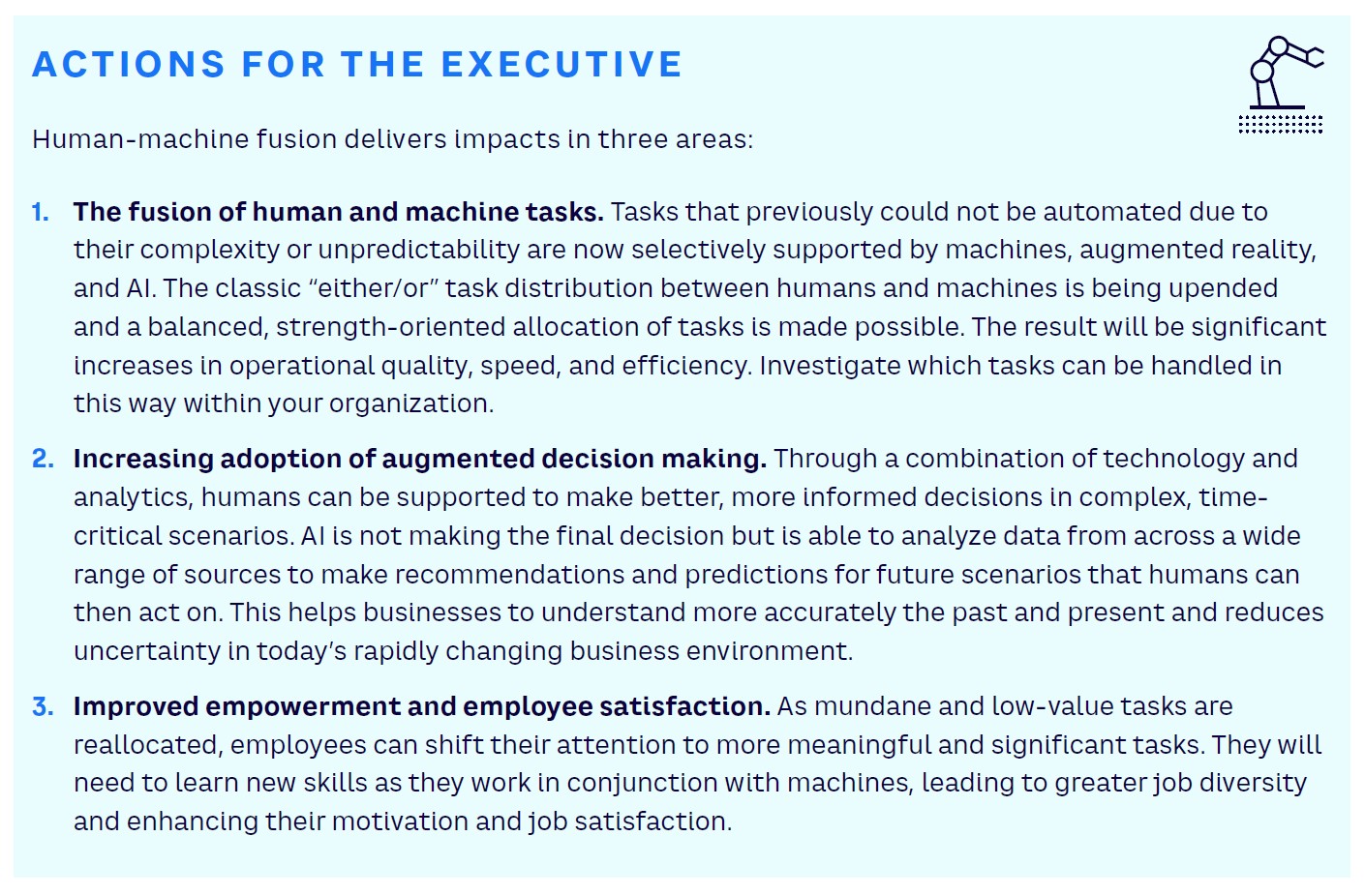
4
AGILE DIGITAL LEADERSHIP
DIGITAL TRANSFORMATION REQUIRES NEW SKILLS FOR SUCCESS
Digital is the new normal. Leadership styles therefore must shift to mastering digital transformations, the impacts of the pandemic, fast-moving markets, and virtual companies.
Successful digital leaders steer and develop their organization by understanding and leveraging the power of technology, and by fueling the company with creativity and a vision for the future. Digital leaders are continually curious and open to learning about new technology to understand how it can deliver business value.
They are also able to build an inclusive culture that makes people feel connected to the company’s mission and to their peers.
Over the past two-plus years of the pandemic, adaptability was seen as the top skill for effective leaders, as they were forced to quickly change organizational focus, manage uncertainties, cope with new regulations, and deliver on shifting market requirements.
Today, leadership requires more than adaptability (see Figure 4). As well as being able to react quickly, leaders need to be an anchor for employees and provide continuity.
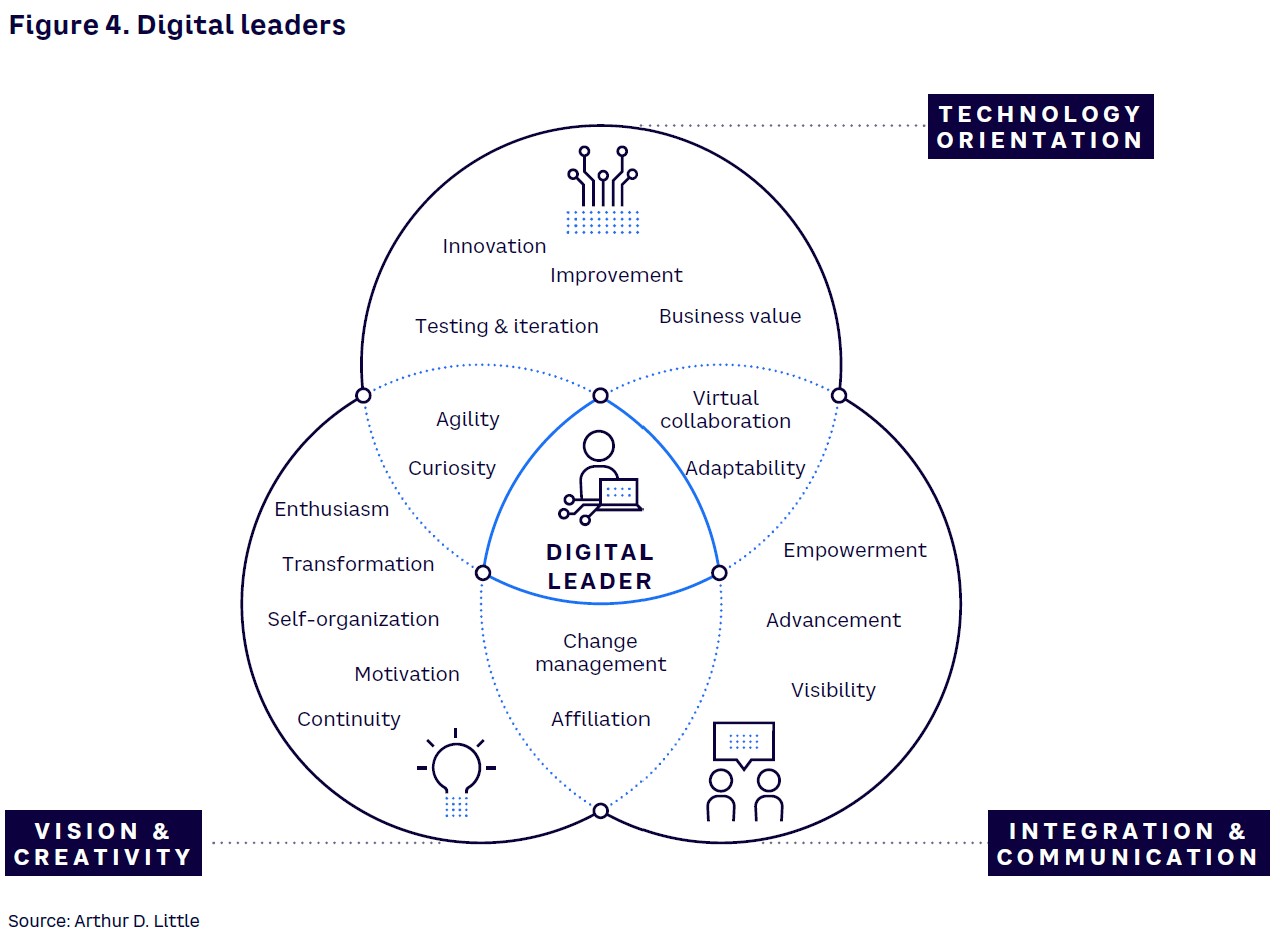
Suitable talent needs to be identified and coached to take on leadership and change-enabling positions. Leaders should also empower self-organized teams, clearly articulating their expectations, guidelines, and responsibilities, while knowing when to step in and out to unlock innovation and motivation.
However, only 30% of digital transformations are successful. That failure is often linked to poor leadership that leads to a lack of employee buy-in, ineffective change management, and unfocused communication. This demonstrates that digital leadership is still in its infancy.
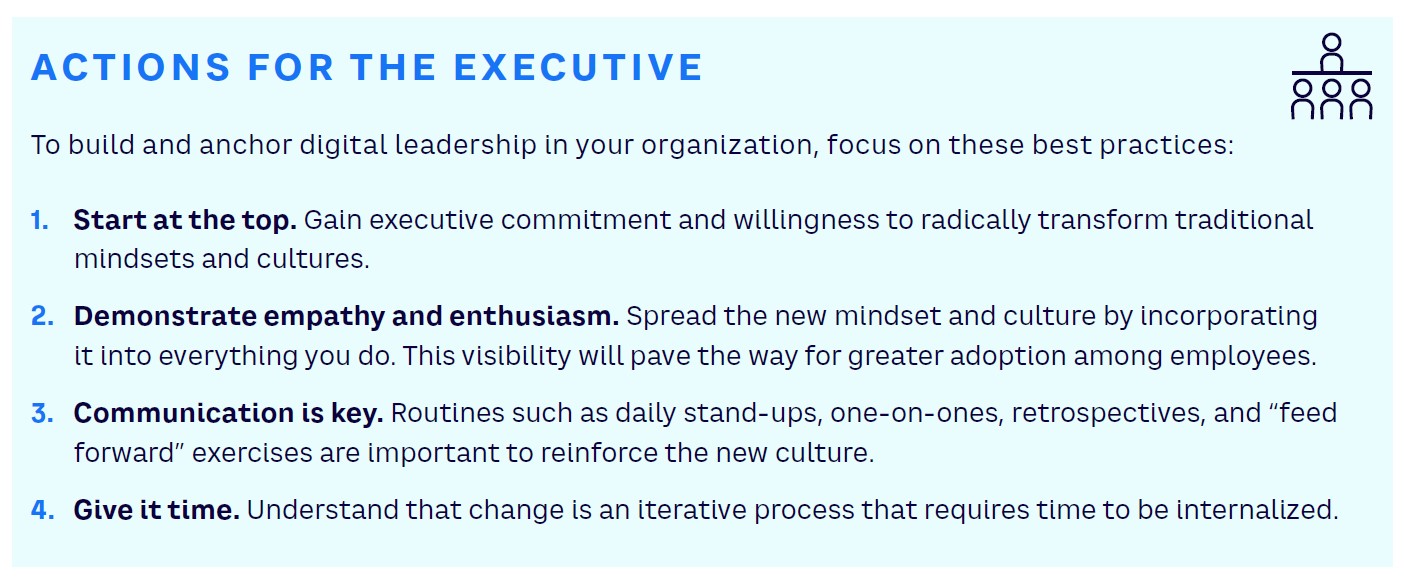
5
GAMIFICATION FOR TRANSFORMATION
USE ELEMENTS OF PLAY TO INDUCE POSITIVE BEHAVIOR IN A SERIOUS CORPORATE ENVIRONMENT
We live — and work — in a time of unprecedented and continuous change. As organizations react and transform, employees need to buy into this change for it to be successful. Yet by nature, humans are suspicious of the risks of change and what it will mean for them and their roles. Creating and driving motivation within teams requires an intelligent approach.
One key to success is translating corporate goals into meaningful personal goals, and inspiring employees to meet these goals on a regular basis. Gamification is a modern approach, using elements of games to move employees in certain directions: playful design elements are fun, transparent information motivates, feedback is instant, and successes are celebrated immediately (see Figure 5).
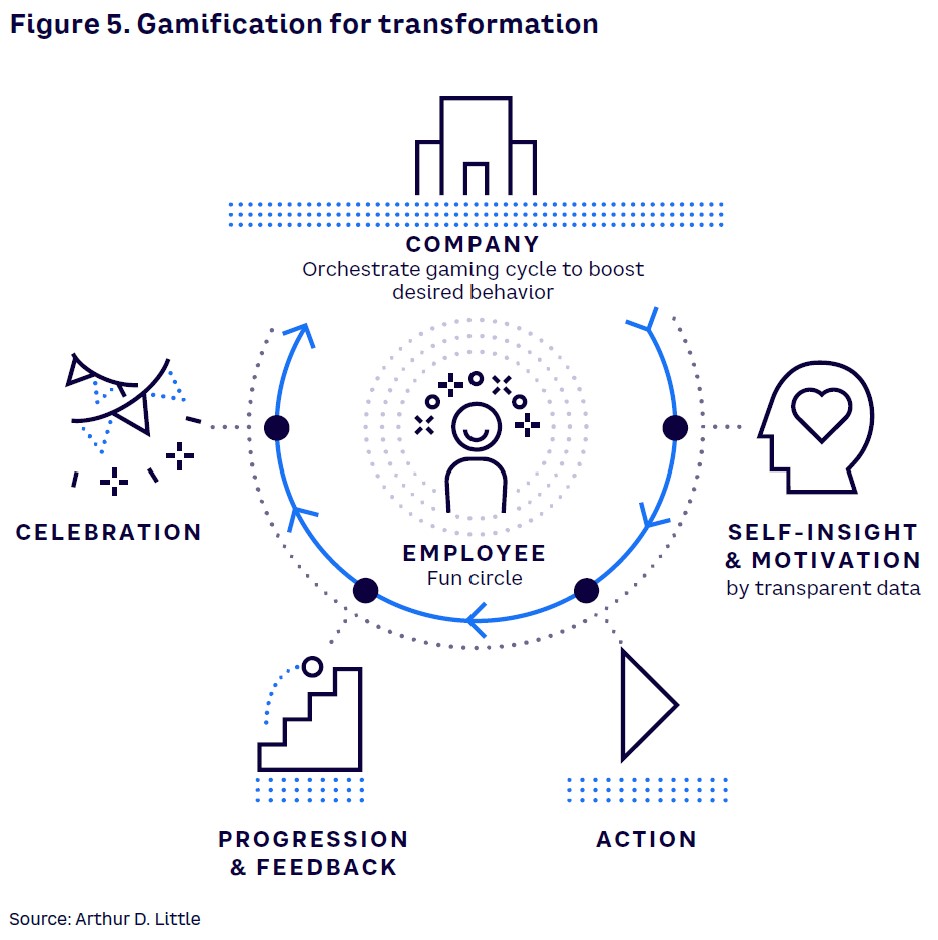
Humans are play animals. While corporate life can be serious and not purely about play, leaders can use gamification elements to induce and reward positive behavior. This is not about deceiving employees, but about adopting a playful approach to certain behaviors that fit with the employee’s own goals.
While it has been adopted by some organizations, the full potential of gamification has not been widely recognized. However, the example of utility British Gas shows the benefits it delivers. The company needed to grow revenues through engineer-generated leads. Traditional financial incentives failed to deliver. Instead, the company built a mobile, game-based app Game of Flames, in which engineers earned points through leads, challenges, and badge unlocks. This released intrinsic motivation within the workforce to drive engagement and increase sales, resulting in a 37% growth in leads.
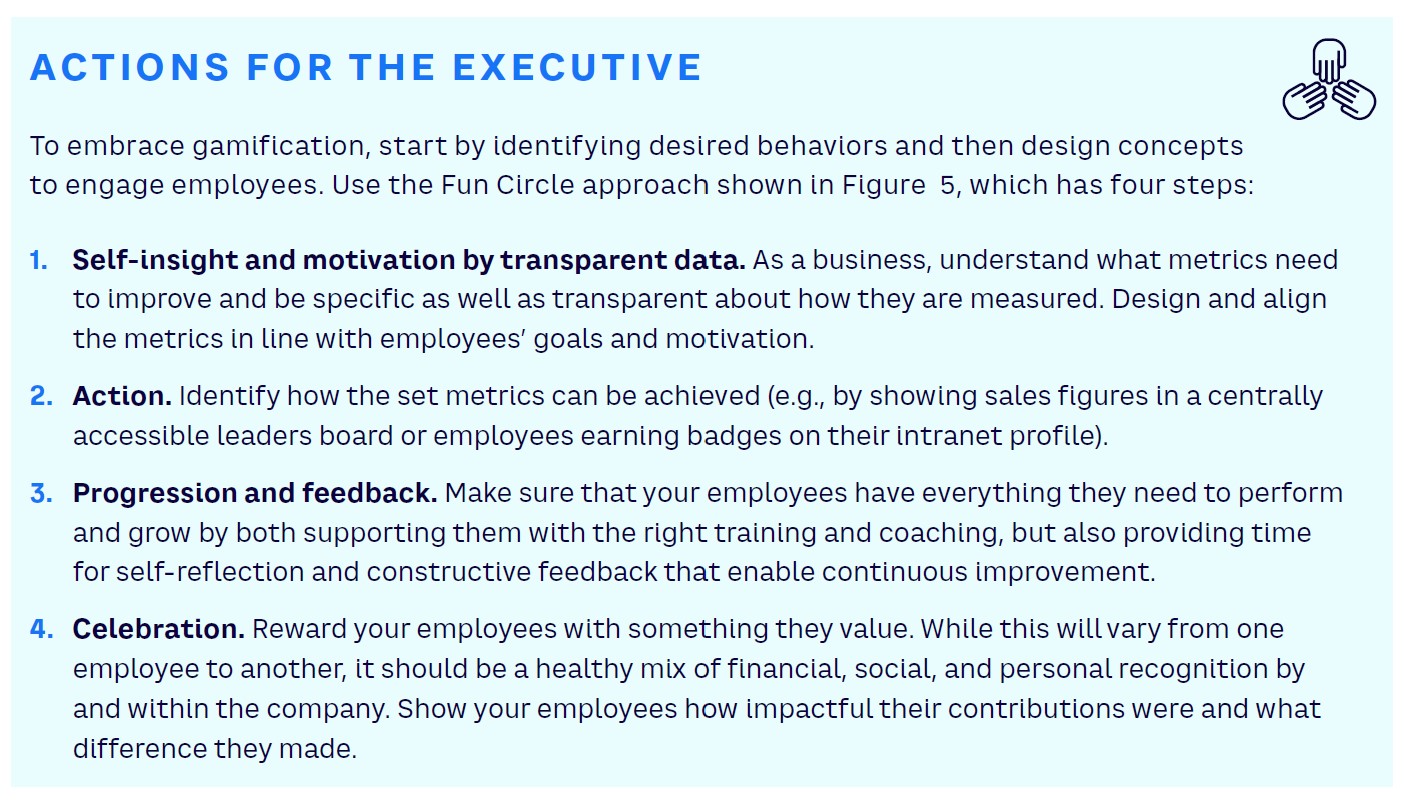
6
AI-EMPOWERED BUSINESS PROCESS AUTOMATION
USE LEARNING MECHANISMS TO AUTOMATE COMPLEX, INFREQUENT ACTIVITIES
Business process automation (BPA) enables organizations to automate repeatable and multistep processes. Generally, these business processes can be divided into three layers that potentially can be automated:
- The user interface or presentation layer, which visualizes the process activities, such as on a screen.
- The processing layer, which describes the ways that data is manipulated, used, and changed within the business process.
- The data layer (including storage and data warehouse), which describes all the data management activities within the process.
Until now, organizations have primarily focused on the first layer of a business process, the presentation layer. Robotic process automation (RPA) is increasingly being implemented to automate these very simple activities, which used to require user input (e.g., transferring data from a PDF to a spreadsheet). RPA requires a form-deterministic logic and structured input (e.g., form fields) to automate the process activity. This means it can only be utilized for process activities that are repetitive and predictable.
AI-empowered BPA goes beyond RPA to directly address the processing and data layers (see Figure 6). It can deal with non-deterministic processes and is able to identify, choose, and combine the most suitable processing and data activities to execute the business process. AI can work with probabilistic, textual, and qualitative unstructured data alongside traditional deterministic, numeric, and quantitative structured data sources. This means it can be used to execute cognitive processes, not only enabling automation but also making these processes completely autonomous.
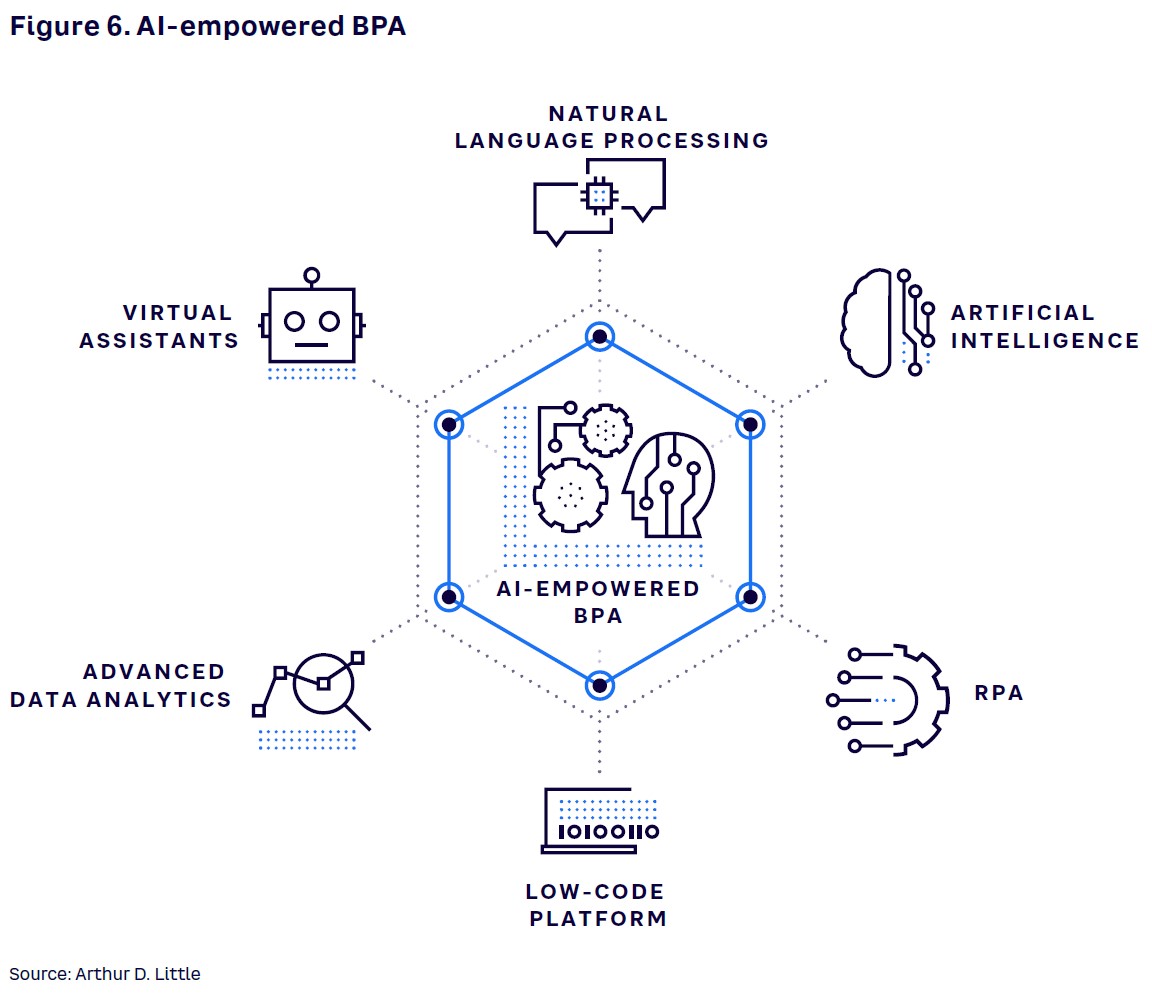
This AI-empowered BPA delivers a significant increase in organizational productivity. For example, the process of loan applications can be made autonomous through AI. Customers apply via mail, with forms automatically scanned and entered into an internal application. Once this step is completed, the customer credit score is extracted and then analyzed by AI. The system can then decide whether the customer fulfils the eligibility criteria to be granted the loan and, if approved, can then transfer the money to the customer following a quality review.
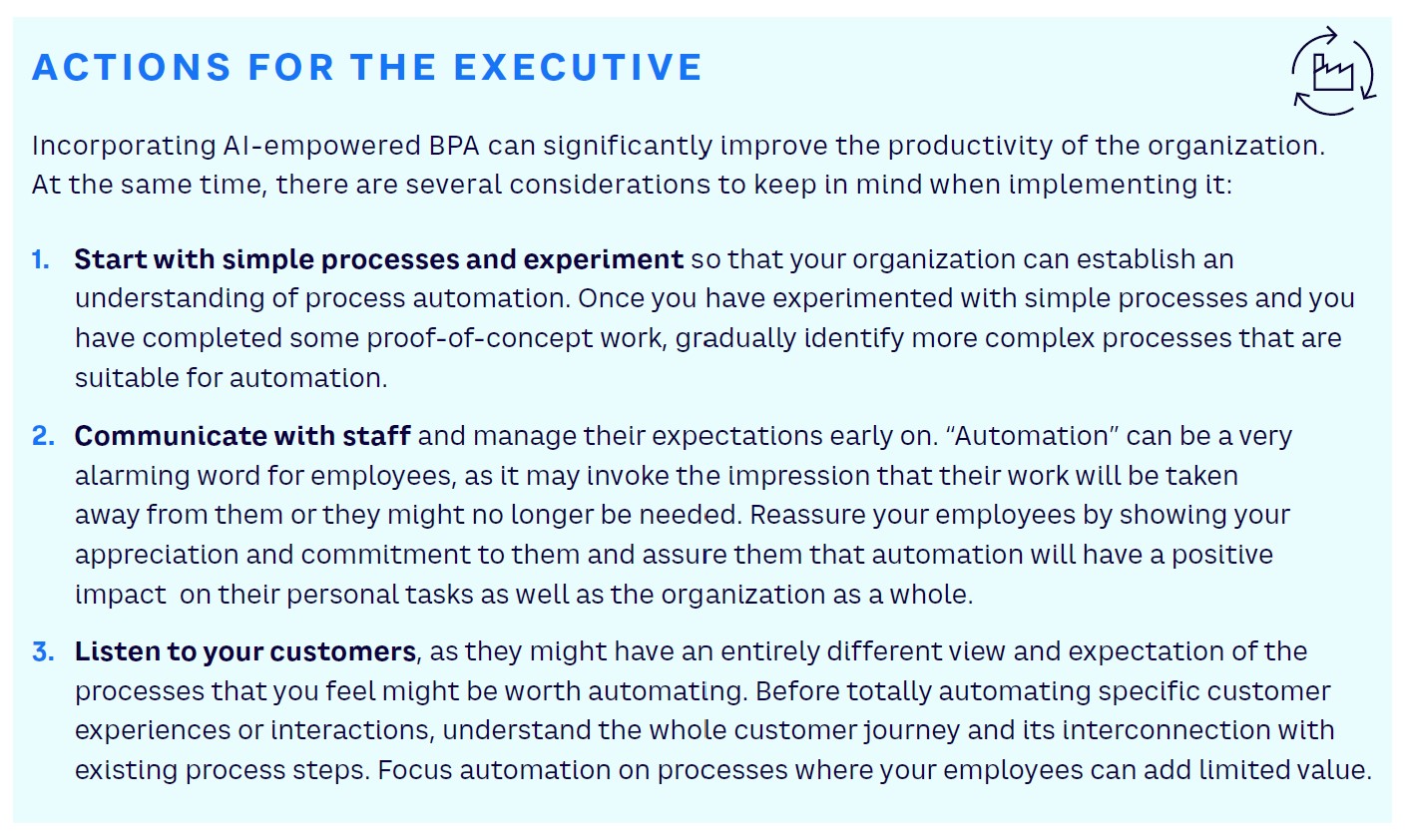
7
TECHNOLOGY/PRIVACY BALANCE
ENSURE COMPLIANCE WITH PRIVACY RIGHTS WHILE INCREASING OPPORTUNITIES
Given the central role technology plays in our lives, it is vital that there is a clear understanding across society of both its benefits and how companies are collecting and sharing personal data. This can be achieved by keeping users informed and ensuring that adequate privacy policies are in place.
The rise of technology has changed the nature of privacy, moving it to the center of public attention. People want to selectively share personal information, but they want to decide who they share information with and determine how their information is processed and used (see Figure 7). They want greater control, an objective supported by growing privacy regulations around the world.
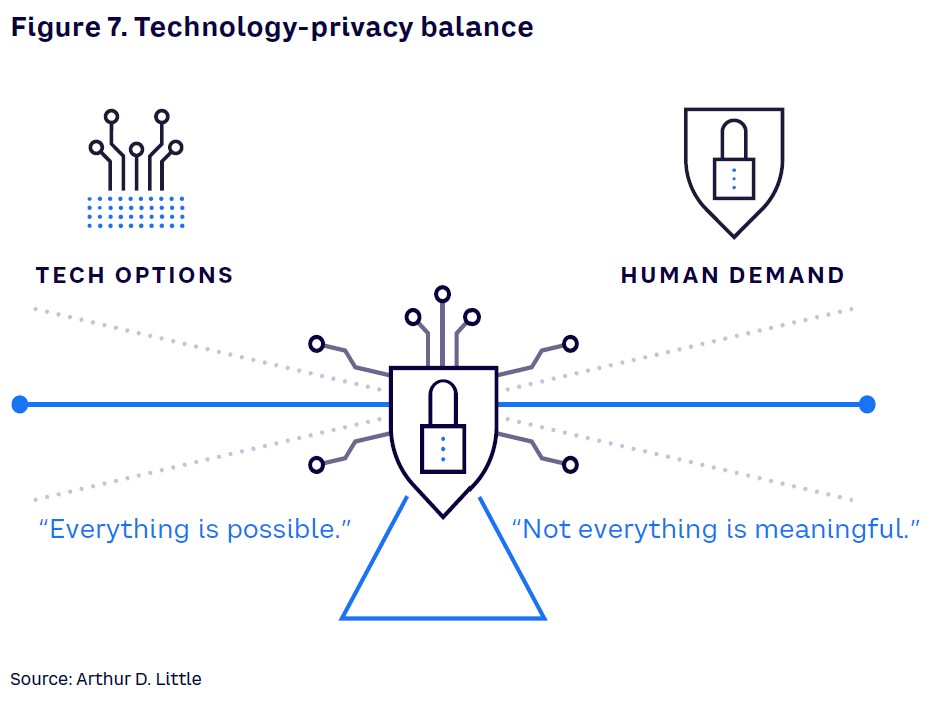
However, until now, privacy practices have focused predominantly on “notice and consent” — essentially telling consumers what an organization is planning to do with their data and gaining their consent. This approach is insufficient.
In fact, a study by Pew Research found that 97% of Americans had been asked to agree to terms and conditions through such privacy policies, with 25% having to consent on a daily basis. However, just 9% said they always read the policy in full before agreeing to the terms and conditions. The complexity of these policies not only impacts the data of private individuals, but also that of businesses as they embrace digital workplace technologies.
It is clear we need fresh approaches based on new principles, as well as enabling businesses to ensure that they meet regulatory standards to protect customer data and other digital assets and prevent privacy issues and data breaches.
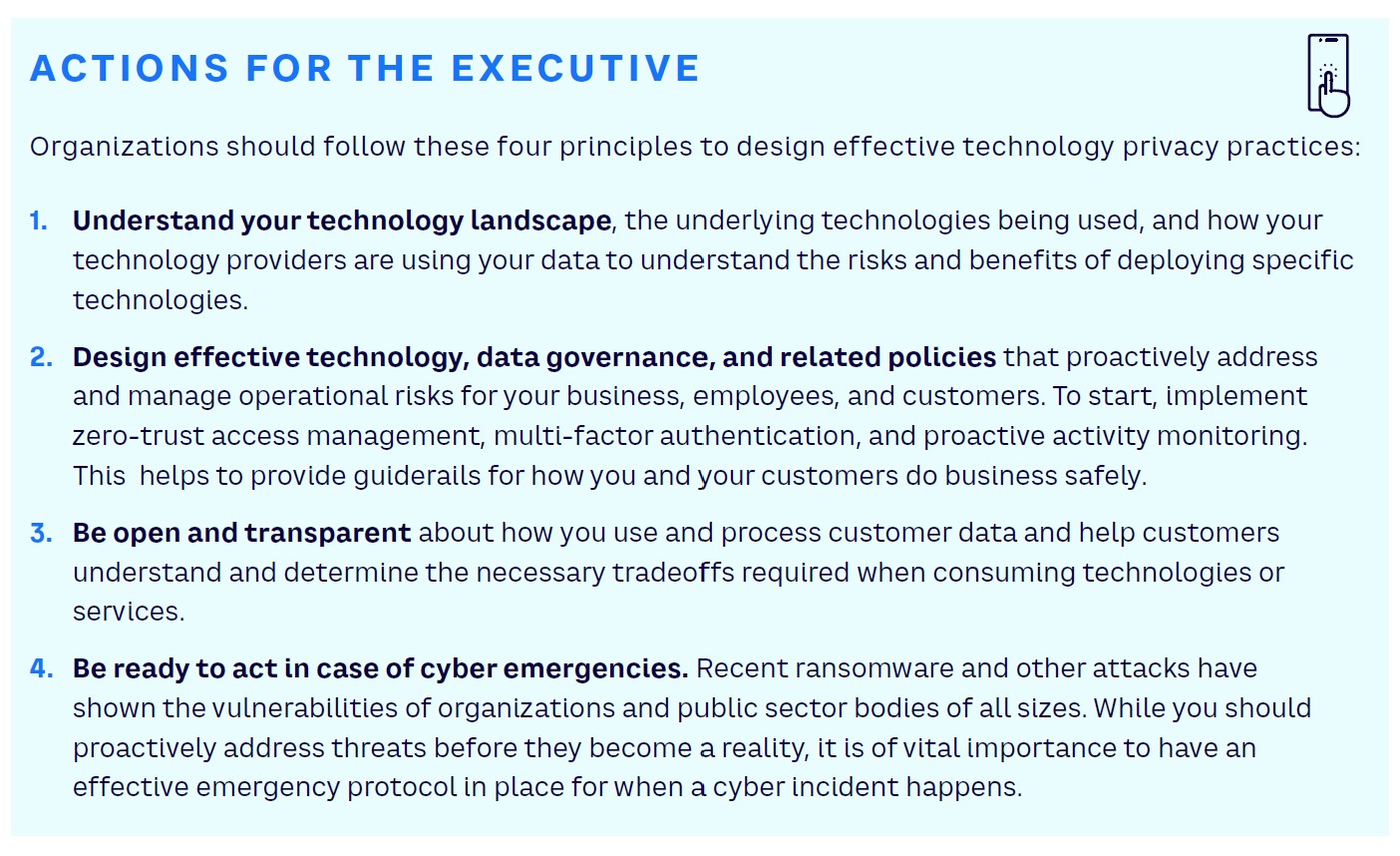
8
TOKENIZATION: A NEW WAY OF TRADING ASSETS
CREATING NEW MARKETS & OPPORTUNITIES FOR FINANCE
Tokenization is the process of transforming a specific, valuable asset into digital tokens that are usable on a blockchain application (see Figure 8). Both tangible assets, such as gold, real estate, or artworks, and intangible assets, including ownership rights, content licensing, and voting rights, can be converted into digital tokens.
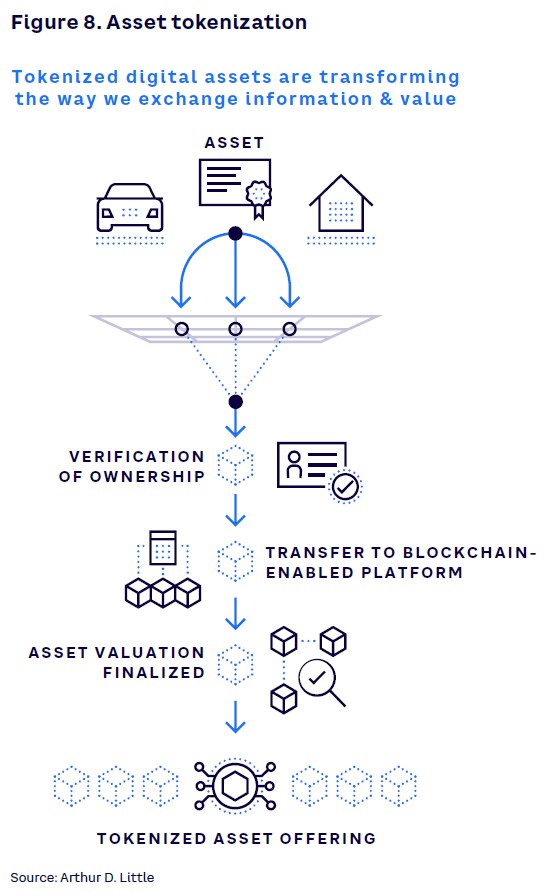
At the heart of tokenization is a decentralized financial system (DeFi) based on blockchain technology that enables efficient trading of assets and operates without traditional intermediaries. Through blockchain technology, ownership, rights, assets, and tangible goods can be digitally represented and contribute to an open and interoperable financial infrastructure. Once created, tokens can be sold and purchased in digital marketplaces.
Tokenization creates a broad field of innovative applications and opens up new forms of collaboration.
A concrete use case for tokenization is in its potential to disrupt markets for capital-intensive assets such as equipment and heavy machinery. Rather than customers buying or leasing the equipment required for their business, tokenization allows for pay-per-use solutions. This creates new business models for equipment manufacturers and the financial services sector, while benefiting firms that typically require capital-intensive assets. Advancements in Internet of Things (IoT) technology, hyperconnectivity, and automated payment solutions are accelerating the trend toward tokenization, thus marking the next step in the transition from product to service-based business models.
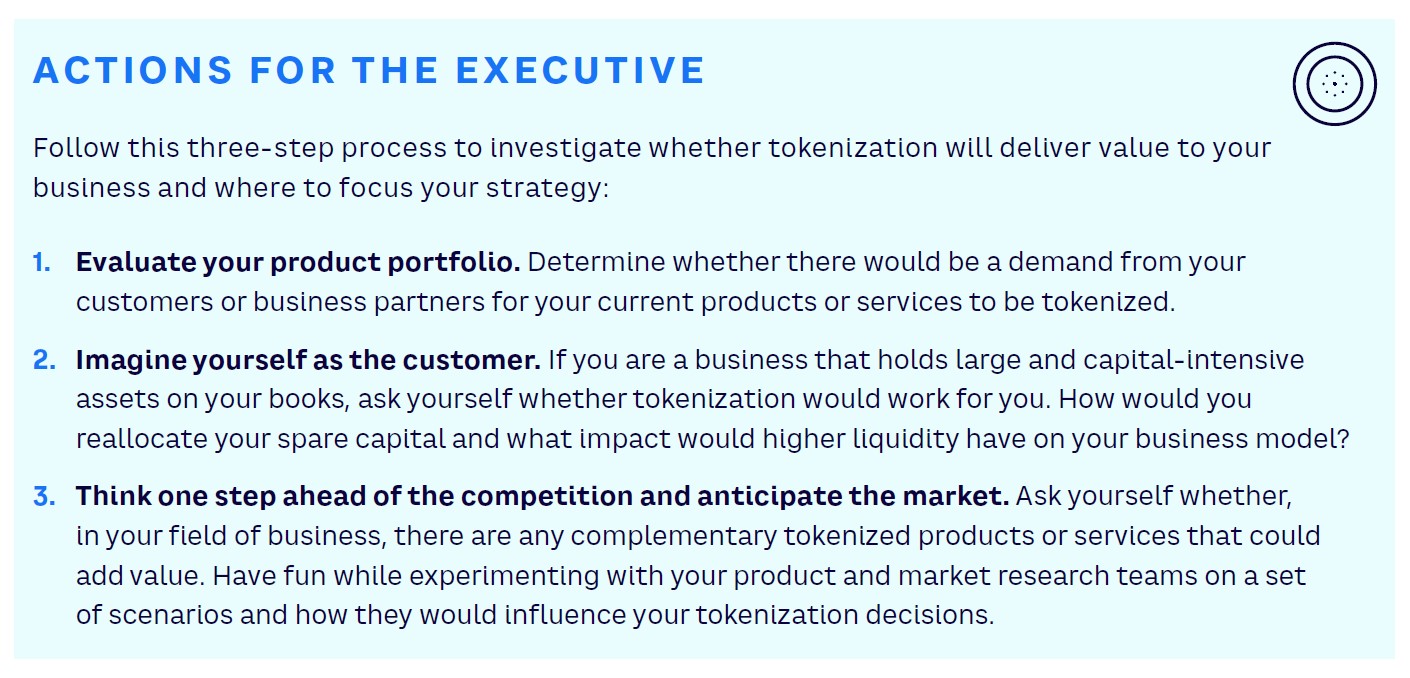
9
HYPERCONNECTIVITY
UNDERSTAND HOW REAL-TIME COMMUNICATIONS WILL IMPACT YOUR BUSINESS
Hyperconnectivity (HC) describes the connectivity that exists in digital environments and the interaction between information systems, data, and devices — all of them connected to each other through the Internet. For consumers and organizations of all shapes, sizes, and purpose, HC provides real-time access to data, enabling instant decision making and more transparent processes.
These advances in connectivity enable everyone to develop new ways of communicating, working, and spending their free time. Simultaneous advances in personal electronics, software, hardware, the metaverse (the emerging space that is merging virtual and real worlds), and the IoT are further fueling the demand for HC in the consumer and business worlds. While there are a wealth of applications and use cases for HC, generally it will allow people, machines, and other digitally enabled assets to share data and take instant actions to ensure they operate smoothly, effectively, and sustainably.
Figure 9 outlines hyperconnectivity’s estimated development timeline, highlighting multiple uses to bring to life the abstract concept behind each development stage.
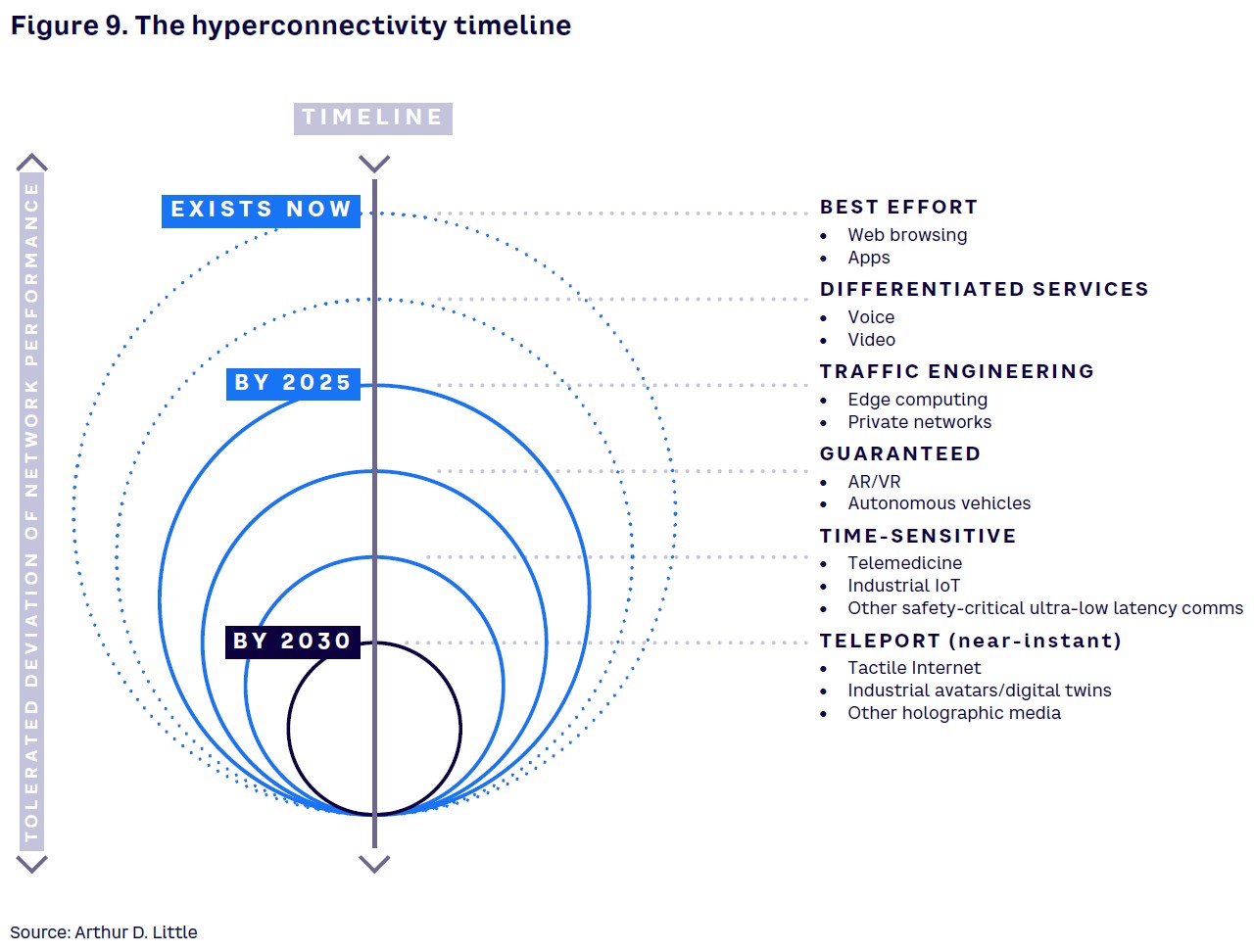
As bandwidth, latency, and connection speed have increased dramatically over time, we have witnessed rapid technology developments that are enabled through stronger, faster, and more reliable connections. With the emergence of 6G by the end of this decade, we anticipate greater technology integration, frictionless user interactions, more immersive user experiences, and new ways to communicate, powered by a data transmission rate that is expected to exceed 1TB per second.
Although we can only speculate, we could see the ability to connect and power more devices in one geographic location, sharp rises in the use of AI-powered robotics, and powerful neural networks that together will empower us in our personal lives as well as fuel the development of new business models and even greater technological innovation.
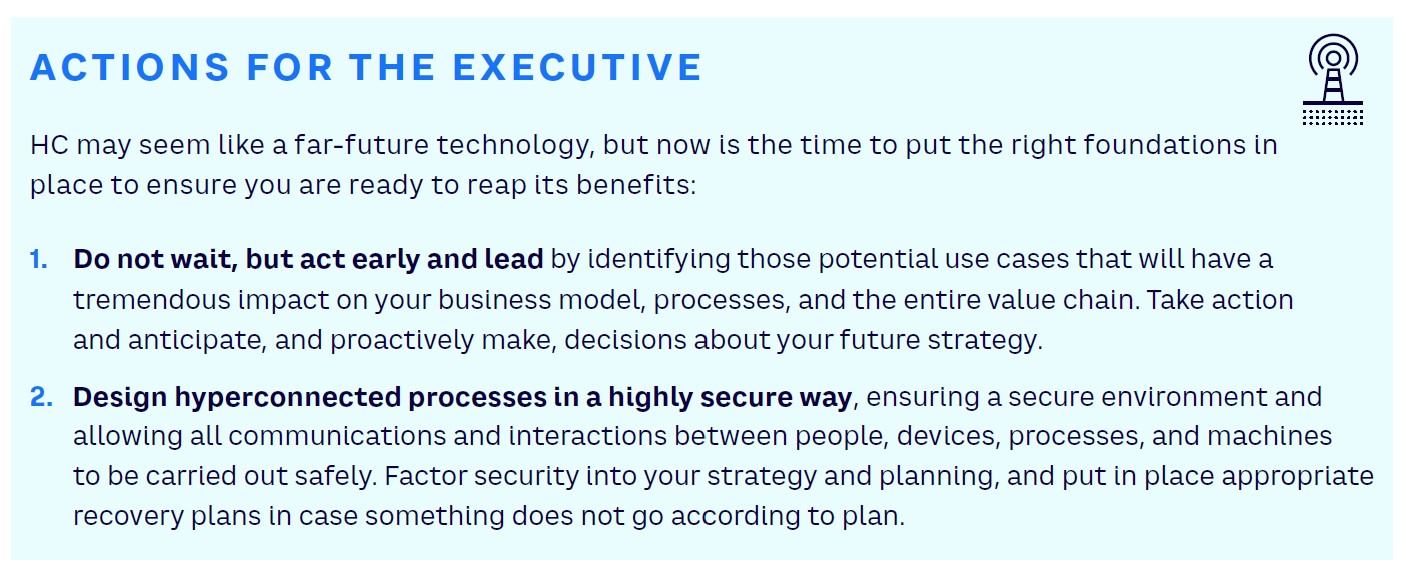
10
NEXT-LEVEL SOFTWARE DEVELOPMENT
BUILD A STRATEGY TO ENSURE LONG-TERM LEADERSHIP
Software leadership is now critical to success across multiple industries, with excellence in software development lowering barriers to entry for new players. For example, traditional automotive players have been disrupted by Tesla, the rise of which has been driven by a focus on software that essentially turns cars into computers on wheels. Competitors like Volkswagen are now trying to follow this example, as we describe in our recent Viewpoint, “Unleashing innovation in IT.”[4]
Additionally, the software development field changes quickly, shaped by a range of heterogeneous trends, including the IoT, microservices and container-based architectures, cloud-native software development, serverless computing, agile ways of working, DevOps, and low code/no code. All of this means that companies need to understand and implement key characteristics if they wish to retain/achieve a technology leadership position. Staying ahead of the curve will require an understanding of the software industry, the technology-related trends driving it, and organizational trends and contexts that create demand for change .
There are four crucially important dimensions to master in order to remain competitive and achieve a leadership position (see Figure 10):
- Technology — embracing new technologies to better meet customer needs.
- Ways of working — being able to balance both scale/efficiency and creativity/innovation.
- People and culture — building a culture that attracts and retains innovators.
- Organization and collaboration — being open and working across ecosystems.
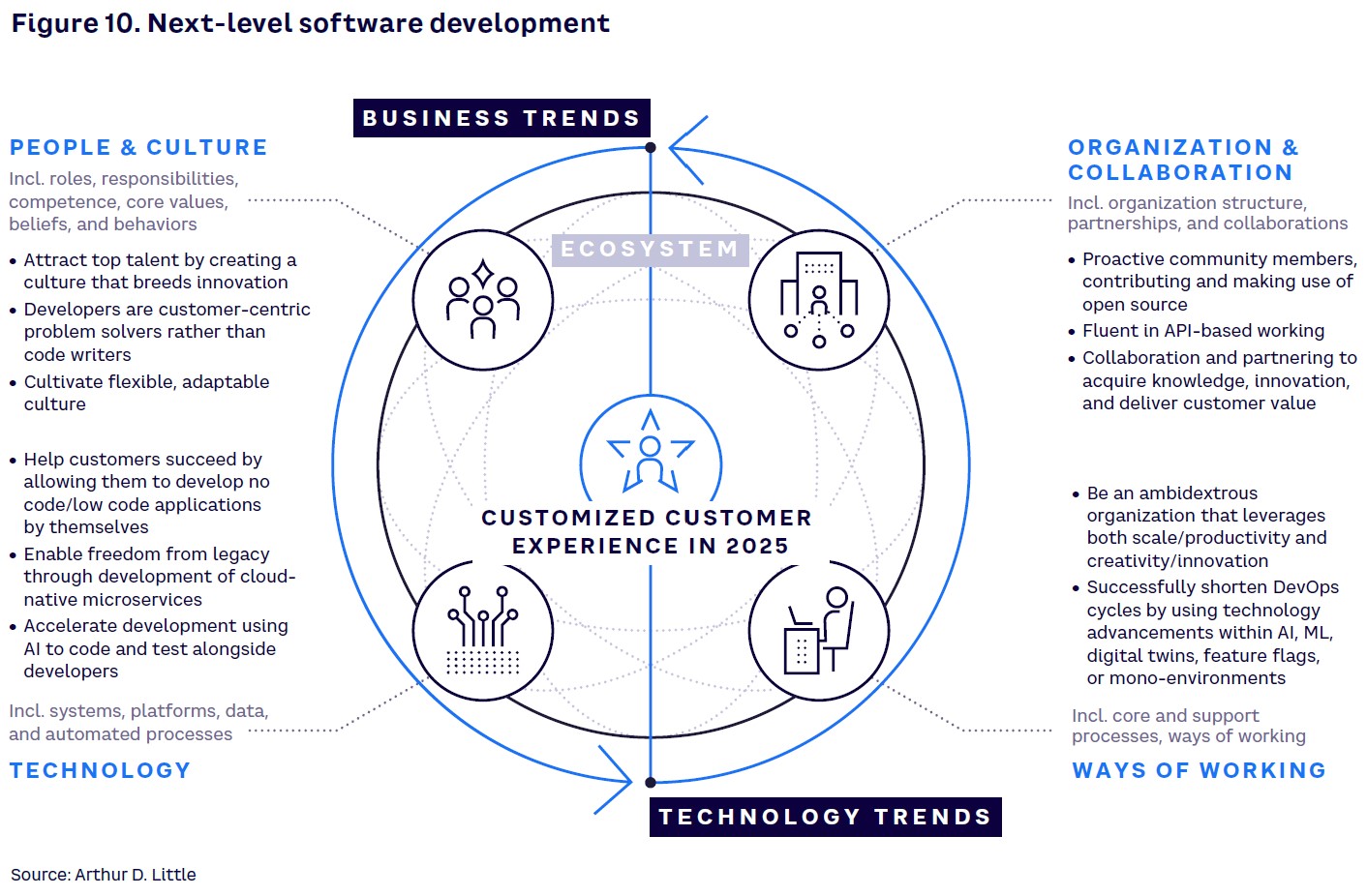
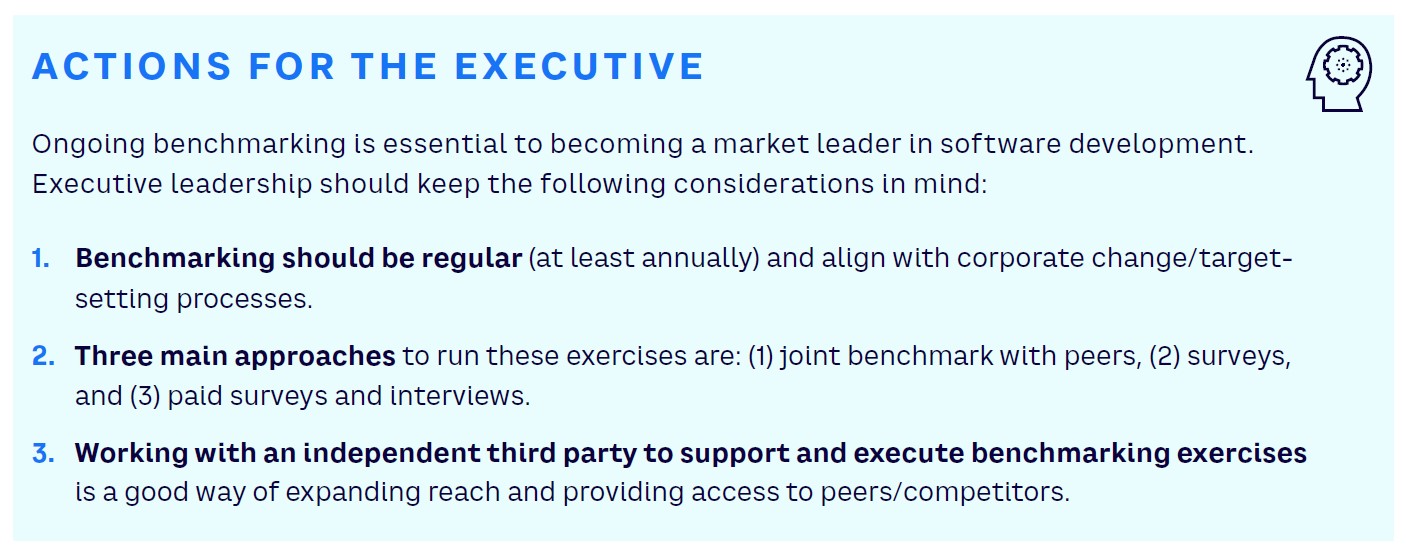
11
CYBERSECURITY CONVERGENCE ACROSS IT & OT
GROWING OPPORTUNITIES, GROWING RISKS
It is time to end the traditional physical and organizational separation between IT and operational technology (OT). IT is usually organized on a group-wide basis, with a focus on computers, storage, and networks, while proprietary OT is the responsibility of individual business units, with a focus on manufacturing equipment and processes in a cyber-physical system (CPS).
Two pressing reasons make this separation obsolete:
- The deep, constant interconnectedness of OT systems with the corporate network.
- The possibilities this creates for cyberattacks that can cause increased damage to the entire business.
Interconnecting OT systems is essential to deliver more automated, adaptive, and thus more efficient production. Leaders like Tesla are showing the way. Through a consistent focus on automation, production at the company’s new Gigafactory near Berlin is up to 30% more efficient compared to established automotive manufacturers. This demonstrates the power of the Industrial Internet of Things (IIoT) to act as a game changer in production systems.
At the same time, cyber risks are growing as this connectivity enables data transfer and remote access and every connected device represents a potential risk. Hence, internal OT networks are becoming vulnerable to external attacks from cyber criminals, leading to substantial potential for damage. For example, significant production losses will result if manufacturing equipment is manipulated or disconnected from power. Despite this threat, many companies still lack the IT know-how in their production teams to develop recovery and contingency plans for their OT systems.
To deliver complete protection, end-to-end cybersecurity approaches are therefore required (see Figure 11). From a technical perspective, they must cover every endpoint and every communication path with coordinated management systems and ensure homogeneity across all company sites. From an organizational perspective, they should encompass and interconnect both IT and OT.
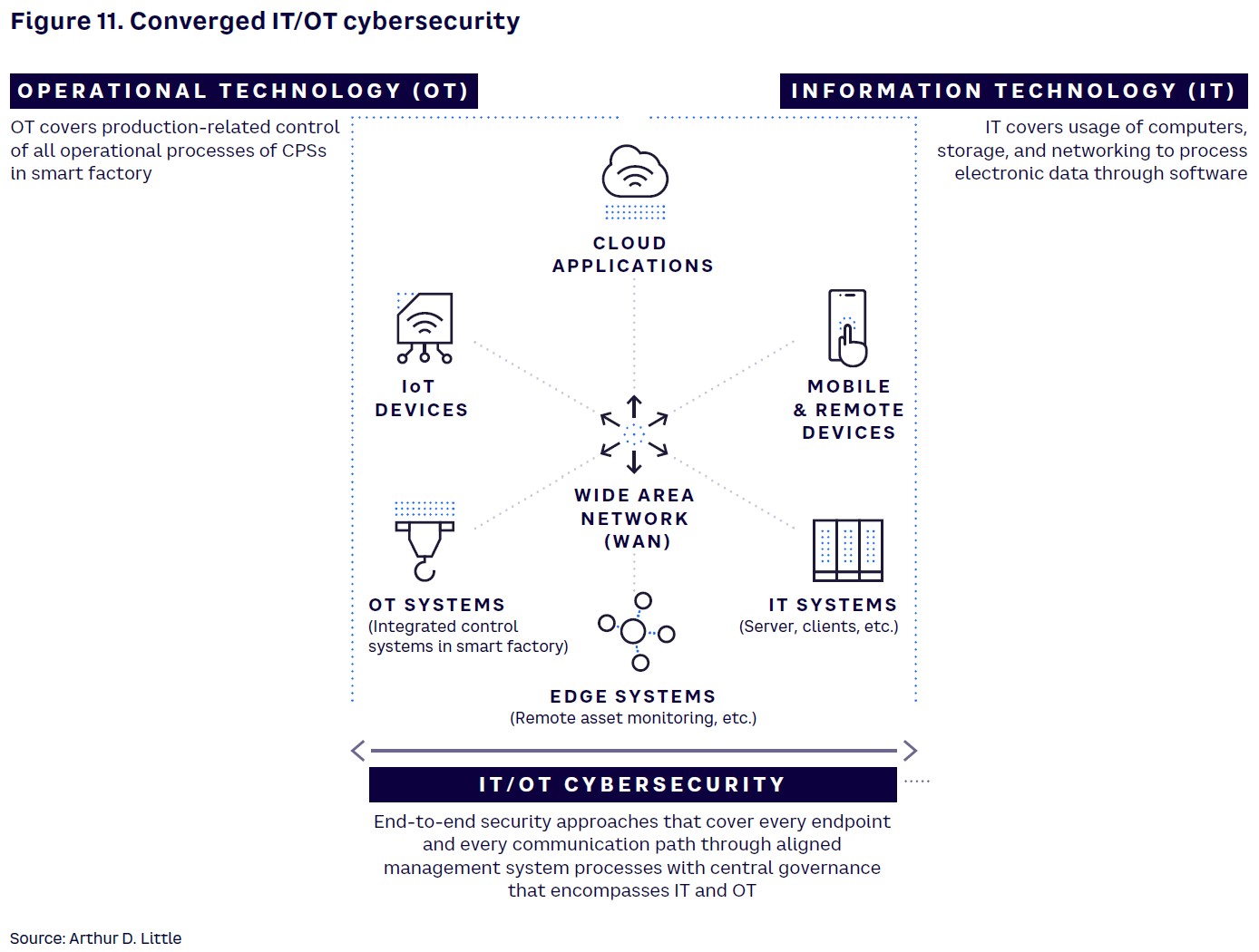
Security responsibilities between IT and OT must also be redefined, resolving conflicting goals between production and security viewpoints (e.g., around the patching of OT systems). Introducing key risk indicators (KRIs) supports this redefinition, enabling companies to predict and assess potential business risks. Through this, the likelihood of potentially catastrophic cyberattacks can be reduced, averting serious security, financial, and reputational losses.
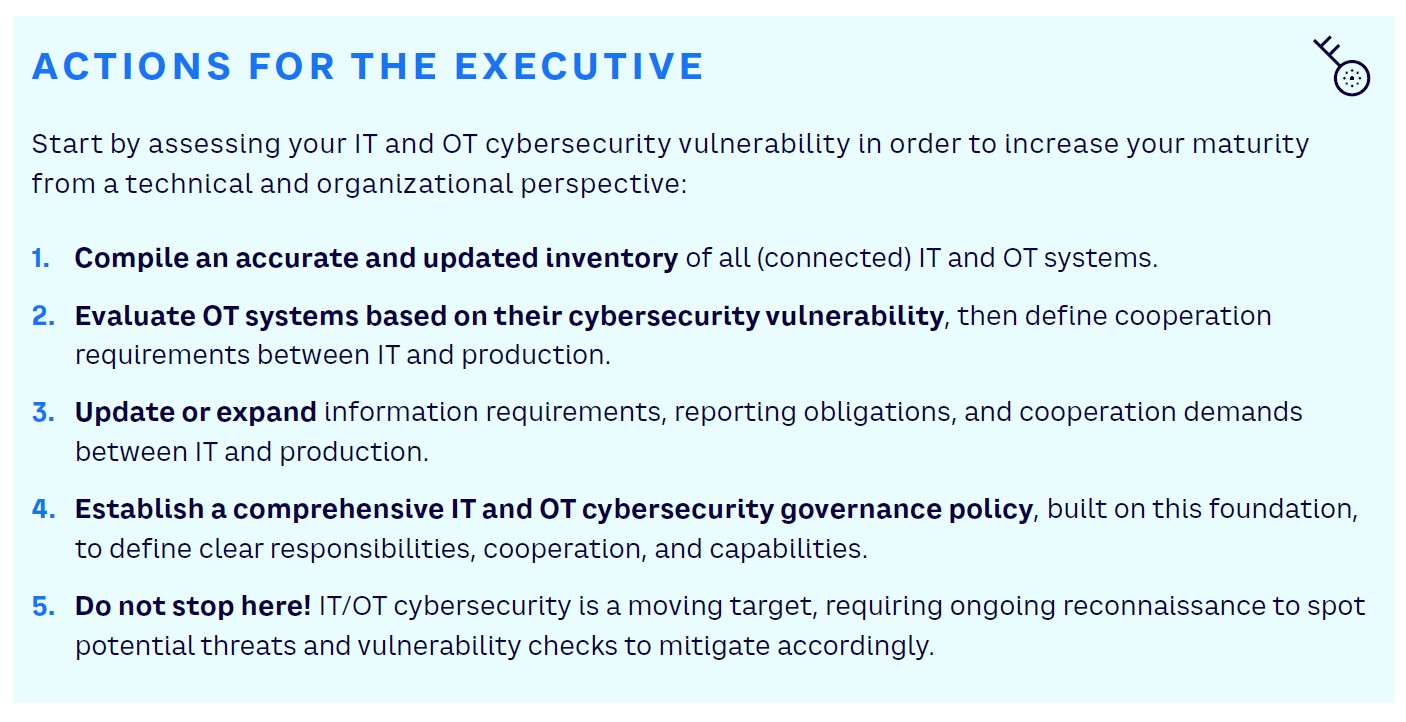
CONCLUSION
Turning technology into business impact
In a world of growing uncertainty, the organizations that succeed will be those that digitize effectively and harness technology to become more agile, innovative, productive, and sustainable.
Transforming through technology requires new skills, capabilities, and leadership, combined with the ability to understand and apply technology where it delivers its greatest benefit. Senior managers should therefore begin by analyzing the short-, medium-, and long-term trends set out in this Report and then look to apply those that are most relevant within their organization to drive future success.
Notes
[1] Eiden, Michael, et al. “From Insight to Impact.” Arthur D. Little, December 2021.
[2] Kolk, Michael, et al. “The Green Gambit.” Prism, 2021.
[3] Meige, Albert, and Michael Papadopoulus. “Metaverse: The Lego Bricks.” Presans, 2022.
[4] Majster, Michael, et al. “Unleashing innovation in IT.” Arthur D. Little, February 2022.
DOWNLOAD THE FULL REPORT
16 min read • Technology & innovation management
11 technology trends for post-crisis success
Breakthrough innovations for future competitive advantage

DATE

Executive Summary
BUILDING A SUCCESSFUL DIGITAL & SUSTAINABLE FUTURE
Accelerated by the COVID-19 pandemic, digitalization has dramatically increased over the last two years, both within companies and across society. At the same time, pressure on companies to counter climate change through new products, processes, and purpose has also grown. Both of these drivers have moved a wide range of technology topics up the strategic agenda for executives, who have often been forced to take immediate action in response to changing trends, new regulations, or the activities of competitors.
Uncertainty and change are continuing in 2022. Geopolitical conflicts are stirring up long-forgotten fears with unimagined and far-reaching consequences for the entire global economy. Watching the news, we can often feel as if everything we previously viewed as fixed and constant has disappeared to be replaced by an alternate reality.
However, uncertainty provides opportunities. One of the biggest threats for organizations is that they miss potential upsides where technology can deliver lasting value or that they are held back by failing to adopt new innovations and ways of working.
To help executives, Arthur D. Little (ADL) has worked with clients to identify some of the most important current and future technology trends, focusing on those that provide the highest business impact in terms of effectiveness and efficiency moving forward. Companies that manage to successfully address these trends will position themselves to build sustainable competitive advantage in the form of higher customer and employee satisfaction, cost benefits, and, most importantly, an edge in technology knowledge and skills.
In this Report, we provide an overview of 11 key trends: from essential foundations (e.g., data-driven business models) to areas that enable competitive differentiation (e.g., artificial intelligence [AI]-empowered business process automation).
1
DATA-DRIVEN BUSINESS MODEL INNOVATION
SHIFT FROM TECHNOLOGY COMPETITION TO ECOSYSTEM SERVICES
Across all sectors, data has become the new currency, with more and more companies basing their business models on data collection and usage.
However, focusing solely on a company’s own business model can narrow thinking and limit the possibilities data can deliver. Often, the real value of data comes from its flexibility and its potential to provide a complete picture. Over half of the value add of data-driven business models stems from ecosystems.
Organizations looking for new business opportunities around data should therefore think cooperatively across industries to leverage the full potential of data-driven business models (see Figure 1). Rather than simply seeing data primarily as a resource to improve existing business models, organizations should instead focus on how their available data can add value to their ecosystem.

When defining the organization’s ecosystem, it is essential to think very broadly and not just focus on the organizations that it interacts with already. It is imperative to look at the bigger picture.
A good example of where data-driven business innovation and collaboration have delivered success is at global flavorings company McCormick, which we featured in our recent ADL Report, “From Insight to Impact.”[1] The company creates new flavorings for customers to incorporate into their products, with the aim of providing a range of options that spans low-innovation, staple products with a high potential for market success as well as more innovative novelty products.
Previously, creating new flavors was a manual process, with product developers combining elements and choosing potential options. Given the enormous range of combinations, it is impossible to manually evaluate each one. McCormick has now worked with IBM to develop an AI system that explores and combines all options within predefined conditions, delivering flavorings with high potential for market success as well as novelty options. Pairing McCormick’s global expertise with leading AI research helped the company accelerate the speed of flavor innovation and deliver highly effective, consumer-preferred formulas.

2
GREEN TECH INVESTMENT FOCUS
GREEN TRANSITION FOR COMPETITIVE EDGE
Our (economic) life is based on the consumption of resources — in the past, present, and future. We classify entire epochs based on the resources that define them, such as the Stone, Copper, Bronze, and Iron Ages. Yet these classifications demonstrate how transient the need for particular resources are.
Today we are facing nothing less than the emergence of a new epoch: the Green Age. Triggered by the desire to combat climate change and reinforced by the urge to reduce geopolitical dependencies through supply chains, a radical change in the socio-technical regime is emerging.
This transition is accompanied by previously unimagined opportunities for companies to gain competitive advantage. Using resources more efficiently and successfully transitioning to green energy are central to future success for industrial companies. The range of potential technologies is wide, with a major focus on sustainable energy production, storage, and more efficient power distribution. This focus is driving the allocation of capital, particularly from (institutional) investors.
These opportunities and ever greater consumer, political, and regulatory pressures are also shaping the CEO’s future strategic agenda. Many are already embracing the opportunity. For example, CEOs of companies such as Deutsche Telekom and IBM have formed the European Green Digital Coalition to aid the implementation of the EU’s Declaration on a Green and Digital Transformation strategy.
In our recent Prism piece “The Green Gambit,”[2] we explain in some detail why now is a perfect time for companies to make bold strategic moves in green investments (see Figure 2). Companies are in a position to adopt a new focus on nurturing disruptive ventures and redefining their role as part of a broader ecosystem, and collaborating with others to shift toward a greener economy. Who dares wins.


3
HUMAN-MACHINE FUSION
MOST OCCUPATIONS COULD SEE ACTIVITIES SHIFT TO HYBRID APPROACH
Previously it has been clear which tasks are allocated to humans and which to machines. Either the machine is faster, more reliable, or more precise, or if the tasks are too complex or creative, they need to be handled by humans.
We are on now on the verge of a new era where technology innovation will lead to a fundamental shift both in business and society, establishing entirely new working relationships between humans and machines.
Certain routine tasks will be allocated to machines and AI algorithms, enabling workers to focus on higher-value tasks. However, in their roles, humans will increasingly work in conjunction with technology (see Figure 3).

The space in which tasks and execution will occur is also changing. We have already experienced new forms of technology-enabled hybrid working during the pandemic. However, developments such as the metaverse will take this to an entirely new level. It will create new symbiotic spaces in which humans and machines will be empowered to seamlessly work in conjunction. In our recent article, “Metaverse: The Lego Bricks,”[3] we introduced a framework that explains the foundational building blocks of the metaverse and its stages of development.
This human-machine fusion will have major implications for both workers and society more generally, which need to be understood and communicated. It also provides tremendous potential to unlock the next wave of sustainable operational performance improvements for businesses and societies alike.
Human-machine fusion is already becoming a reality. Email programs automatically suggest replies based on the content of messages, chatbots take customers through the process of returning an item, and voice analysis routes calls to the most relevant department without an operator’s involvement. This bot-based empowerment is just one of the many growing examples of human-machine fusion.

4
AGILE DIGITAL LEADERSHIP
DIGITAL TRANSFORMATION REQUIRES NEW SKILLS FOR SUCCESS
Digital is the new normal. Leadership styles therefore must shift to mastering digital transformations, the impacts of the pandemic, fast-moving markets, and virtual companies.
Successful digital leaders steer and develop their organization by understanding and leveraging the power of technology, and by fueling the company with creativity and a vision for the future. Digital leaders are continually curious and open to learning about new technology to understand how it can deliver business value.
They are also able to build an inclusive culture that makes people feel connected to the company’s mission and to their peers.
Over the past two-plus years of the pandemic, adaptability was seen as the top skill for effective leaders, as they were forced to quickly change organizational focus, manage uncertainties, cope with new regulations, and deliver on shifting market requirements.
Today, leadership requires more than adaptability (see Figure 4). As well as being able to react quickly, leaders need to be an anchor for employees and provide continuity.

Suitable talent needs to be identified and coached to take on leadership and change-enabling positions. Leaders should also empower self-organized teams, clearly articulating their expectations, guidelines, and responsibilities, while knowing when to step in and out to unlock innovation and motivation.
However, only 30% of digital transformations are successful. That failure is often linked to poor leadership that leads to a lack of employee buy-in, ineffective change management, and unfocused communication. This demonstrates that digital leadership is still in its infancy.

5
GAMIFICATION FOR TRANSFORMATION
USE ELEMENTS OF PLAY TO INDUCE POSITIVE BEHAVIOR IN A SERIOUS CORPORATE ENVIRONMENT
We live — and work — in a time of unprecedented and continuous change. As organizations react and transform, employees need to buy into this change for it to be successful. Yet by nature, humans are suspicious of the risks of change and what it will mean for them and their roles. Creating and driving motivation within teams requires an intelligent approach.
One key to success is translating corporate goals into meaningful personal goals, and inspiring employees to meet these goals on a regular basis. Gamification is a modern approach, using elements of games to move employees in certain directions: playful design elements are fun, transparent information motivates, feedback is instant, and successes are celebrated immediately (see Figure 5).

Humans are play animals. While corporate life can be serious and not purely about play, leaders can use gamification elements to induce and reward positive behavior. This is not about deceiving employees, but about adopting a playful approach to certain behaviors that fit with the employee’s own goals.
While it has been adopted by some organizations, the full potential of gamification has not been widely recognized. However, the example of utility British Gas shows the benefits it delivers. The company needed to grow revenues through engineer-generated leads. Traditional financial incentives failed to deliver. Instead, the company built a mobile, game-based app Game of Flames, in which engineers earned points through leads, challenges, and badge unlocks. This released intrinsic motivation within the workforce to drive engagement and increase sales, resulting in a 37% growth in leads.

6
AI-EMPOWERED BUSINESS PROCESS AUTOMATION
USE LEARNING MECHANISMS TO AUTOMATE COMPLEX, INFREQUENT ACTIVITIES
Business process automation (BPA) enables organizations to automate repeatable and multistep processes. Generally, these business processes can be divided into three layers that potentially can be automated:
- The user interface or presentation layer, which visualizes the process activities, such as on a screen.
- The processing layer, which describes the ways that data is manipulated, used, and changed within the business process.
- The data layer (including storage and data warehouse), which describes all the data management activities within the process.
Until now, organizations have primarily focused on the first layer of a business process, the presentation layer. Robotic process automation (RPA) is increasingly being implemented to automate these very simple activities, which used to require user input (e.g., transferring data from a PDF to a spreadsheet). RPA requires a form-deterministic logic and structured input (e.g., form fields) to automate the process activity. This means it can only be utilized for process activities that are repetitive and predictable.
AI-empowered BPA goes beyond RPA to directly address the processing and data layers (see Figure 6). It can deal with non-deterministic processes and is able to identify, choose, and combine the most suitable processing and data activities to execute the business process. AI can work with probabilistic, textual, and qualitative unstructured data alongside traditional deterministic, numeric, and quantitative structured data sources. This means it can be used to execute cognitive processes, not only enabling automation but also making these processes completely autonomous.

This AI-empowered BPA delivers a significant increase in organizational productivity. For example, the process of loan applications can be made autonomous through AI. Customers apply via mail, with forms automatically scanned and entered into an internal application. Once this step is completed, the customer credit score is extracted and then analyzed by AI. The system can then decide whether the customer fulfils the eligibility criteria to be granted the loan and, if approved, can then transfer the money to the customer following a quality review.

7
TECHNOLOGY/PRIVACY BALANCE
ENSURE COMPLIANCE WITH PRIVACY RIGHTS WHILE INCREASING OPPORTUNITIES
Given the central role technology plays in our lives, it is vital that there is a clear understanding across society of both its benefits and how companies are collecting and sharing personal data. This can be achieved by keeping users informed and ensuring that adequate privacy policies are in place.
The rise of technology has changed the nature of privacy, moving it to the center of public attention. People want to selectively share personal information, but they want to decide who they share information with and determine how their information is processed and used (see Figure 7). They want greater control, an objective supported by growing privacy regulations around the world.

However, until now, privacy practices have focused predominantly on “notice and consent” — essentially telling consumers what an organization is planning to do with their data and gaining their consent. This approach is insufficient.
In fact, a study by Pew Research found that 97% of Americans had been asked to agree to terms and conditions through such privacy policies, with 25% having to consent on a daily basis. However, just 9% said they always read the policy in full before agreeing to the terms and conditions. The complexity of these policies not only impacts the data of private individuals, but also that of businesses as they embrace digital workplace technologies.
It is clear we need fresh approaches based on new principles, as well as enabling businesses to ensure that they meet regulatory standards to protect customer data and other digital assets and prevent privacy issues and data breaches.

8
TOKENIZATION: A NEW WAY OF TRADING ASSETS
CREATING NEW MARKETS & OPPORTUNITIES FOR FINANCE
Tokenization is the process of transforming a specific, valuable asset into digital tokens that are usable on a blockchain application (see Figure 8). Both tangible assets, such as gold, real estate, or artworks, and intangible assets, including ownership rights, content licensing, and voting rights, can be converted into digital tokens.

At the heart of tokenization is a decentralized financial system (DeFi) based on blockchain technology that enables efficient trading of assets and operates without traditional intermediaries. Through blockchain technology, ownership, rights, assets, and tangible goods can be digitally represented and contribute to an open and interoperable financial infrastructure. Once created, tokens can be sold and purchased in digital marketplaces.
Tokenization creates a broad field of innovative applications and opens up new forms of collaboration.
A concrete use case for tokenization is in its potential to disrupt markets for capital-intensive assets such as equipment and heavy machinery. Rather than customers buying or leasing the equipment required for their business, tokenization allows for pay-per-use solutions. This creates new business models for equipment manufacturers and the financial services sector, while benefiting firms that typically require capital-intensive assets. Advancements in Internet of Things (IoT) technology, hyperconnectivity, and automated payment solutions are accelerating the trend toward tokenization, thus marking the next step in the transition from product to service-based business models.

9
HYPERCONNECTIVITY
UNDERSTAND HOW REAL-TIME COMMUNICATIONS WILL IMPACT YOUR BUSINESS
Hyperconnectivity (HC) describes the connectivity that exists in digital environments and the interaction between information systems, data, and devices — all of them connected to each other through the Internet. For consumers and organizations of all shapes, sizes, and purpose, HC provides real-time access to data, enabling instant decision making and more transparent processes.
These advances in connectivity enable everyone to develop new ways of communicating, working, and spending their free time. Simultaneous advances in personal electronics, software, hardware, the metaverse (the emerging space that is merging virtual and real worlds), and the IoT are further fueling the demand for HC in the consumer and business worlds. While there are a wealth of applications and use cases for HC, generally it will allow people, machines, and other digitally enabled assets to share data and take instant actions to ensure they operate smoothly, effectively, and sustainably.
Figure 9 outlines hyperconnectivity’s estimated development timeline, highlighting multiple uses to bring to life the abstract concept behind each development stage.

As bandwidth, latency, and connection speed have increased dramatically over time, we have witnessed rapid technology developments that are enabled through stronger, faster, and more reliable connections. With the emergence of 6G by the end of this decade, we anticipate greater technology integration, frictionless user interactions, more immersive user experiences, and new ways to communicate, powered by a data transmission rate that is expected to exceed 1TB per second.
Although we can only speculate, we could see the ability to connect and power more devices in one geographic location, sharp rises in the use of AI-powered robotics, and powerful neural networks that together will empower us in our personal lives as well as fuel the development of new business models and even greater technological innovation.

10
NEXT-LEVEL SOFTWARE DEVELOPMENT
BUILD A STRATEGY TO ENSURE LONG-TERM LEADERSHIP
Software leadership is now critical to success across multiple industries, with excellence in software development lowering barriers to entry for new players. For example, traditional automotive players have been disrupted by Tesla, the rise of which has been driven by a focus on software that essentially turns cars into computers on wheels. Competitors like Volkswagen are now trying to follow this example, as we describe in our recent Viewpoint, “Unleashing innovation in IT.”[4]
Additionally, the software development field changes quickly, shaped by a range of heterogeneous trends, including the IoT, microservices and container-based architectures, cloud-native software development, serverless computing, agile ways of working, DevOps, and low code/no code. All of this means that companies need to understand and implement key characteristics if they wish to retain/achieve a technology leadership position. Staying ahead of the curve will require an understanding of the software industry, the technology-related trends driving it, and organizational trends and contexts that create demand for change .
There are four crucially important dimensions to master in order to remain competitive and achieve a leadership position (see Figure 10):
- Technology — embracing new technologies to better meet customer needs.
- Ways of working — being able to balance both scale/efficiency and creativity/innovation.
- People and culture — building a culture that attracts and retains innovators.
- Organization and collaboration — being open and working across ecosystems.


11
CYBERSECURITY CONVERGENCE ACROSS IT & OT
GROWING OPPORTUNITIES, GROWING RISKS
It is time to end the traditional physical and organizational separation between IT and operational technology (OT). IT is usually organized on a group-wide basis, with a focus on computers, storage, and networks, while proprietary OT is the responsibility of individual business units, with a focus on manufacturing equipment and processes in a cyber-physical system (CPS).
Two pressing reasons make this separation obsolete:
- The deep, constant interconnectedness of OT systems with the corporate network.
- The possibilities this creates for cyberattacks that can cause increased damage to the entire business.
Interconnecting OT systems is essential to deliver more automated, adaptive, and thus more efficient production. Leaders like Tesla are showing the way. Through a consistent focus on automation, production at the company’s new Gigafactory near Berlin is up to 30% more efficient compared to established automotive manufacturers. This demonstrates the power of the Industrial Internet of Things (IIoT) to act as a game changer in production systems.
At the same time, cyber risks are growing as this connectivity enables data transfer and remote access and every connected device represents a potential risk. Hence, internal OT networks are becoming vulnerable to external attacks from cyber criminals, leading to substantial potential for damage. For example, significant production losses will result if manufacturing equipment is manipulated or disconnected from power. Despite this threat, many companies still lack the IT know-how in their production teams to develop recovery and contingency plans for their OT systems.
To deliver complete protection, end-to-end cybersecurity approaches are therefore required (see Figure 11). From a technical perspective, they must cover every endpoint and every communication path with coordinated management systems and ensure homogeneity across all company sites. From an organizational perspective, they should encompass and interconnect both IT and OT.

Security responsibilities between IT and OT must also be redefined, resolving conflicting goals between production and security viewpoints (e.g., around the patching of OT systems). Introducing key risk indicators (KRIs) supports this redefinition, enabling companies to predict and assess potential business risks. Through this, the likelihood of potentially catastrophic cyberattacks can be reduced, averting serious security, financial, and reputational losses.

CONCLUSION
Turning technology into business impact
In a world of growing uncertainty, the organizations that succeed will be those that digitize effectively and harness technology to become more agile, innovative, productive, and sustainable.
Transforming through technology requires new skills, capabilities, and leadership, combined with the ability to understand and apply technology where it delivers its greatest benefit. Senior managers should therefore begin by analyzing the short-, medium-, and long-term trends set out in this Report and then look to apply those that are most relevant within their organization to drive future success.
Notes
[1] Eiden, Michael, et al. “From Insight to Impact.” Arthur D. Little, December 2021.
[2] Kolk, Michael, et al. “The Green Gambit.” Prism, 2021.
[3] Meige, Albert, and Michael Papadopoulus. “Metaverse: The Lego Bricks.” Presans, 2022.
[4] Majster, Michael, et al. “Unleashing innovation in IT.” Arthur D. Little, February 2022.
DOWNLOAD THE FULL REPORT